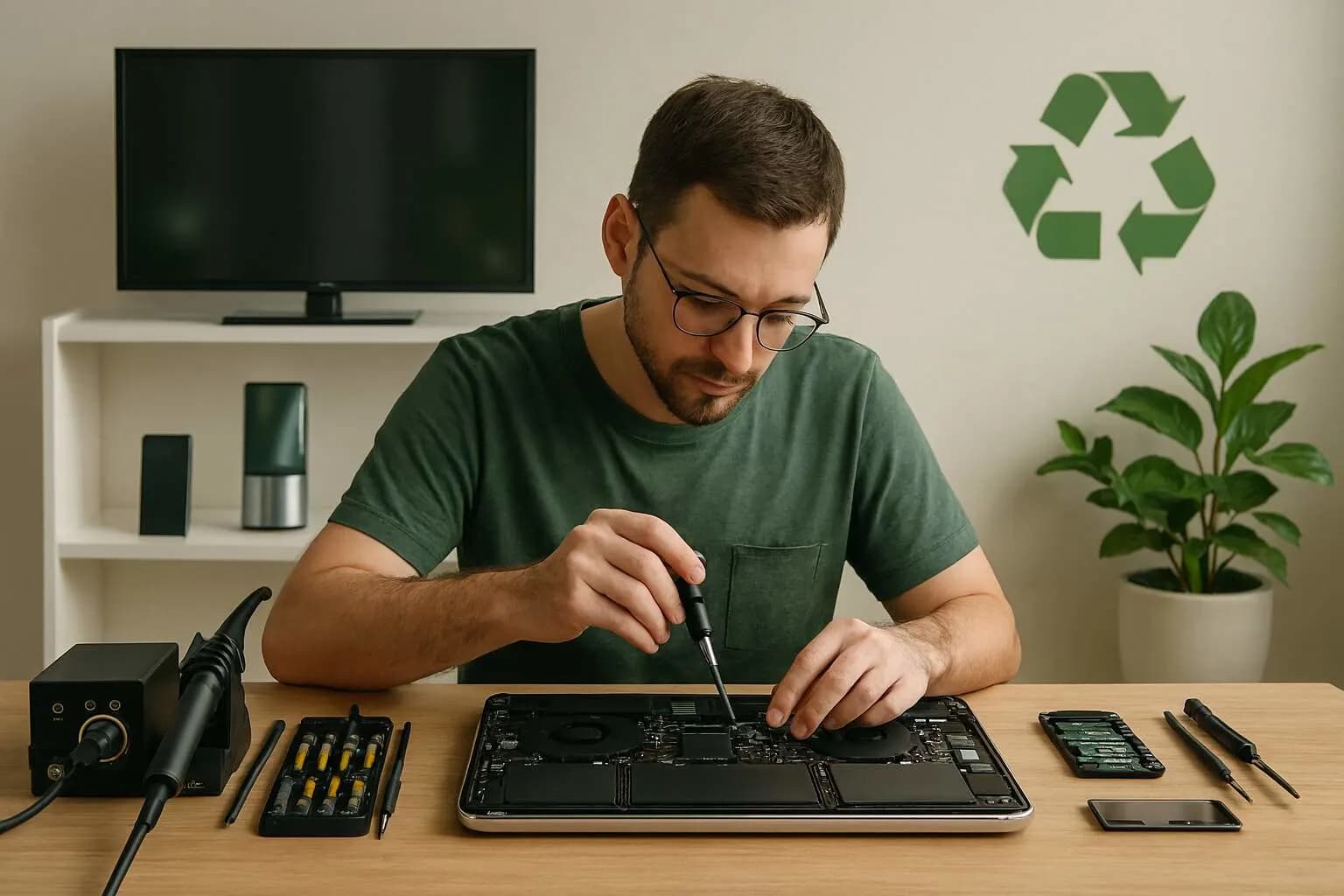BLOG / HOW TO
How to Dispose of Your Electronics


Whether you have an old phone sitting in a desk drawer or a broken laptop collecting dust in the back of a closet, there has never been a better moment to dispose of it. There's a strong possibility your discarded item will be put to good use again, and it can even earn you some money or benefit someone else. Recycling should be a last choice, but if there are no other options for your device, there are ways to discard electronics safely.
In 2022, the world produced a record 62 million metric tons of e-waste, but only 22.3% was formally recycled. By 2023, 81 countries had e-waste laws, though recycling rates remain uneven—Europe leads at 42.8% while Africa is below 1%. With e-waste growing by about 2.6 million tons annually, it could hit 82 million tons by 2030, with recycling dropping to 20% if stronger action isn’t taken. Outdated devices often end up in unsafe dumps, harming communities, and in 2022 alone an estimated 5.3 billion phones were discarded. The need for better solutions is urgent—governments, businesses, and individuals must act.
The Environmental and Health Impact of E-Waste 🔗
E-waste disposal that is not done properly endangers both the environment and human health. Toxic chemicals can leak into soil and water when e-waste is disposed of or burnt, contaminating natural resources and damaging ecosystems. Exposure to dangerous compounds in e-waste can cause major health concerns such as respiratory troubles, skin ailments, neurological damage, and even cancer. To reduce these dangers, it is critical to implement long-term e-waste management strategies.
How to Responsibly Dispose of Your Electronics 🔗
Proper disposal of electronics prevents harmful waste, protects the environment, and supports recycling. Here’s how you can responsibly handle old devices instead of letting them end up in landfills.
Use Devices for Longer 🔗
Before you discard devices, consider using them for a bit longer. Do you truly need an upgrade? Perhaps you can reuse your old equipment to get more use out of it. For example, you could repurpose an old phone into a webcam. If you're determined to get a new device, look into ethical and environmentally friendly options. Look for manufacturers and merchants who provide trade-in and recycling programs.
Consider buying secondhand items from eBay or other marketplaces, or hunt for refurbished electronics. Manufacturers such as Apple and Samsung sell refurbished electronics at a discount, and Amazon has a huge selection of refurbished products. Elizabeth Chamberlain, iFixit's head of sustainability, suggests Back Market for reconditioned phones. For more information and ideas, see our guide to purchasing used or refurbished devices.
Repair and Refurbish 🔗

Whether you intend to get more out of a device, pass it on to someone, or sell it, fixing or refurbishing it first is a wise decision. If you want to try to fix a device yourself, iFixit is a wonderful place to start. It has over 90,000 step-by-step repair tips for smartphones, tablets, laptops, PCs, game consoles, and cameras.
YouTube is another wonderful location to get repair videos. Chamberlain advises checking out repair techs like Louis Rossmann, Jessa Jones, Ben's Appliances and Junk, and Rich Rebuilds, but there are plenty of repair videos for the precise item you're searching for.
Find a repair cafe in your region to meet repair pros and learn how to mend your gadgets in person. These local pop-up events provide free advice and knowledge sharing from skilled repairers to help neighbors get their goods mended. Instead of shipping off gadgets for repair, you sit with a professional and learn how to troubleshoot them yourself. The Restart Project is a wonderful resource for those in the UK who want to repair or donate equipment.
When attempting to repair a phone, laptop, or other gadget with a battery inside, remember to drain the battery before opening it.
Rubber gloves and rubber-soled boots can help reduce the risk of electric shock when repairing major white-good equipment.
If you lack the confidence to undertake repairs yourself, browsing evaluations will most certainly lead you to a reliable local repair shop. The Federal Trade Commission discovered that independent repair shops have the same success and safety record as manufacturer shops. Many manufacturers have discouraged repairs by threatening to void the warranty, but victories for the Right to Repair movement have resulted in technology becoming marginally more repairable.
Just be sure to back up and secure critical data on your devices before dropping them off at a repair shop. Some devices may even include a built-in solution.
Pass Devices On 🔗
Passing devices on to family members, friends, and neighbors who can utilize them is the most effective approach to maximize their worth. "Don't let devices hibernate in a junk drawer or closet and waste away," advises SERI's Jeff Seibert. "Get them into someone else's hands who can use them as quickly as possible because the older devices get, the less positive impact they can make."
If you don't know anyone who could use your old devices, try the Freecycle Network or local Buy Nothing Facebook groups to find people looking for freebies.
Resell 🔗
Consider reselling your gadget on places like Poshmark or eBay to extend its lifespan. These products will be repurposed by someone else, or their components will be recycled. You can find out how to remove all of your personal data from your devices. You must do this before reselling the device.
Recycle 🔗
If you are unable to continue using or reselling your devices, make sure you recycle them appropriately. Twenty-five states have particular e-waste legislation, so be sure you understand the requirements in your jurisdiction. Before recycling, make sure to delete all personal information from the device, remove any batteries (which may need to be recycled separately), and place any damaged pieces in sealed containers to prevent dangerous materials from leaking. When working with broken electronics, always wear gloves.
Earth911 or e-stewards.org will help you identify the nearest recycling centers for your devices. Electronic recyclers who display the E-Steward logo on their websites have been certified to satisfy the cleanest and most responsible e-waste standards. Best Buy, Staples, and Goodwill are among more convenient locations that accept e-waste for recycling. The EPA also maintains a list of facilities that accept various forms of e-waste for recycling.
Donate 🔗

If you like the idea of your old electronics being put to good use, consider donating them to charities or community programs. Many organizations follow a reuse-first approach, ensuring devices are used as long as possible before recycling. You can also find local charities that accept electronics through donation networks. Some nonprofits provide donated phones to military personnel so they can stay connected with loved ones, while others distribute phones and tablets to vulnerable groups such as survivors of domestic violence, senior citizens, or underserved communities. Fitness-related devices are also accepted by certain programs that refurbish and share them to promote health and wellness.
Hire a Junk Removal Service 🔗
If you want the fastest and most reliable way to get rid of old electronics, nothing beats hiring a professional junk removal service. Unlike donation drop-offs, DIY recycling, or waiting weeks for a municipal program, junk removal gives you an immediate, hassle-free solution right at your doorstep.
This option isn’t just about convenience—it’s about responsibility and peace of mind. Electronics are loaded with hazardous materials like lead, mercury, and heavy metals. Mishandling them can cause serious environmental damage and even lead to costly fines. A trusted junk removal company takes that burden off your shoulders, guaranteeing your devices are collected, transported, and disposed of properly.
With junk removal, you skip the uncertainty of other methods and choose the one option that’s fast, compliant, and worry-free.
Conclusion 🔗
Disposing of electronics responsibly is essential to protecting the environment, conserving resources, and reducing harmful waste. Instead of throwing old devices in the trash, explore options like donating, recycling, or returning them through manufacturer take-back programs. Small choices—like safely reusing or recycling your gadgets—can make a big difference when multiplied across millions of people. By taking these steps, you not only clear out clutter but also contribute to a cleaner, safer, and more sustainable future.
Frequently Asked Questions - How to Get Rid of Electronics 🔗
Why shouldn’t I throw electronics in the trash? 🔗
Electronics contain toxic materials like lead, mercury, and cadmium that can leak into soil and water if left in landfills. Proper disposal prevents environmental harm.
What is the best way to dispose of old electronics? 🔗
The best options are recycling through certified e-waste programs, donating working devices to charities, or using manufacturer take-back and trade-in services.
Can I donate electronics that no longer work? 🔗
Yes, many organizations accept non-working devices for parts or refurbishment. Always check with the charity or recycling program first.
How can I make sure my personal data is safe before donating or recycling? 🔗
Wipe your devices by performing a factory reset, removing memory cards, and erasing stored files. For added security, use certified data destruction software.
Do all recycling centers accept electronics? 🔗
Not all centers are equipped for e-waste. Look for certified e-waste recyclers or community collection events dedicated to electronics.
What happens to recycled electronics? 🔗
Recycled devices are dismantled so valuable materials like copper, gold, and plastic can be recovered and reused, reducing the need for raw material mining.
Is there a cost to recycle electronics? 🔗
Some programs are free, while others may charge a small fee, especially for large appliances like TVs and monitors. Many retailers also offer free drop-off services.
KB Choudhury is the Chief Executive Officer of WeCycle, a technology-driven platform dedicated to transforming the recycling and waste management industry. Under his leadership, WeCycle focuses on creating efficient, data-powered solutions that simplify waste collection, promote eco-friendly practices, and support a sustainable circular economy. Choudhury’s vision for WeCycle centers on leveraging innovation and digital tools to make recycling smarter, more accessible, and impactful for both businesses and communities.
Related blogs
Quick junk removal services — find your price
Enter your zip code to see if Wecycle operates in your location.



